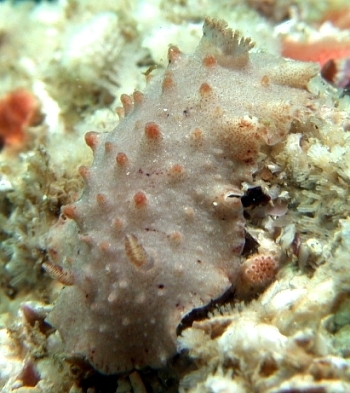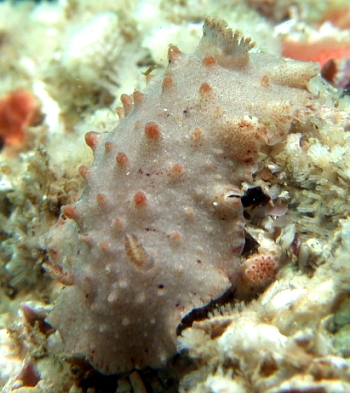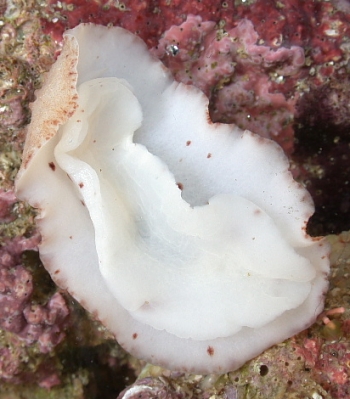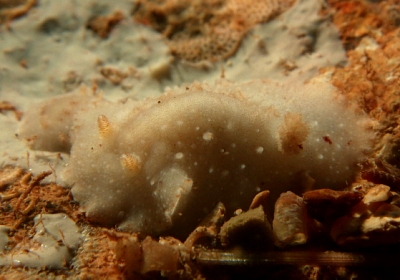
Paradoris lopezi
Hermosillo & Valdes, 2004
Order: NUDIBRANCHIA
Suborder: DORIDINA
Superfamily: EUDORIDOIDEA
Family: Discodorididae
DISTRIBUTION
Known only from 2 specimens from the Pacific coast of Mexico
PHOTO
Locality: Rocky shores, 20 feet, Puerto Vallarta, Mexico, Eastern Pacific, Subtidal. Length: 26 mm. Photographer: Alicia Hermosillo.
This is species is a dull grey or brown with conical rounded tubercles scattered over the mantle, the larger ones being tipped with pinkish brown. Small, almost microscopic opaque white spheres are closely packed in the skin, and sometimes they appear to have a blackish or brownish central spot. Around the mantle edge there is scattered brownish pigmentation creating a brownish band around the mantle edge.
Dayrat (2006) describes a mantle pocked with 'wide holes'. I can see no sign of them in photogrpahs of living animals and can only presume they are an artifact of SEM preparation. Perhaps the opaque white spheres are gland cells, and the 'wide holes' are the collapsed remnants of these cells?
The largest known specimen approximately 30 mm long.
- Dayrat, B. (2006) A taxonomic revision of Paradoris sea slugs (Mollusca, Gastropoda, Nudibranchia, Doridina). Zoological Journal of the Linnean Society 147: 125-238.
- Hermosillo A. & Valdés, A. (2005). Two new Dorids (Mollusca: Opisthobranchia) of Bahía de Banderas and La Paz, México. Proceedings of the California Academy of Sciences, 55(28): 550-560, 5 figs.
Rudman, W.B., 2007 (March 1) Paradoris lopezi Hermosillo & Valdes, 2004. [In] Sea Slug Forum. Australian Museum, Sydney. Available from http://www.seaslugforum.net/find/paralope
Related messages
Paradoris lopezi from Mexico
March 2, 2007
From: Alicia Hermosillo


Dear Bill,
Finally after 5 years of hard work, I finished up and got my PhD at the end of last year. .. so now I have a bit more time on my hands, I have been going over your species list and noticed you do not have Paradoris lopezi Hermosillo & Valdes, so please, let me introduce it.
-
Hermosillo A. & Valdés, A. (2005) Two new Dorids (Mollusca: Opisthobranchia) of Bahía de Banderas and La Paz, México. Proceedings of the California Academy of Sciences, 55( 28): 550-560, 5 figs.
If anybody out there is interested in my thesis (in Spanish) I would be very happy to send the pdf document.
Cheers
Ali (or Dr. Ali now I guess!)
gueri25@hotmail.com
Hermosillo, A., 2007 (Mar 2) Paradoris lopezi from Mexico. [Message in] Sea Slug Forum. Australian Museum, Sydney. Available from http://www.seaslugforum.net/find/19524
Dear Dr Ali,
Congratulations on your Ph.D. It doesn't seem so long ago that you first wrote to the Forum. Thanks for the information on Paradoris lopezi. It has made me fix up a few other Paradoris species - so I'll make today a Paradoris day
In Dayrat's (2006) exhaustive review, he considers 'wide holes on the dorsal notum' to be a character of Paradoris, and they are certainly present in your SEM photos of the mantle of Paradoris lopezi. What puzzles me is that I can't see them in the photos of the living animals and although they are present in SEM mounts published by Dayrat for Paradoris dubia, I have never seen them in living animals. Perhaps they are gland sacs which have collapsed during the preparation of tissue for SEM study?. Interestingly, in your description of Paradoris lopezi you mention that P. lopezi produces a milky substance when disturbed, which, as I note on the P. dubia Fact Sheet, I have often observed from the mantle glands of that species .
Best wishes,
Bill Rudman
